![]()
![]()
![]()
Use LEFT and RIGHT arrow keys to navigate between flashcards;
Use UP and DOWN arrow keys to flip the card;
H to show hint;
A reads text to speech;
416 Cards in this Set
- Front
- Back
|
Anatomy
|
the structure of the body
|
|
|
Physiology
|
the processes or functions of living things
|
|
|
Homeostasis
|
existence and maintenance of a relatively constant environment within the body
|
|
|
Normal Range
|
body temperature increases and decreases slightly around the set point (ideal value)
|
|
|
Tissue;
Types? (4) |
a group of similar cells and the materials surrounding them
4 Types: Epithelial, Connective, Muscle, and Nervous |
|
|
Organ
|
Organs are composed of two or more tissue types that together perform one or more common functions.
|
|
|
Organ System;
Types? |
a group of organs classified as a unit because of a common function or set of functions
Types: integumentary, skeletal, muscular, lymphatic, respiratory, digestive, nervous, endocrine, cardiovascular, urinary, and reproductive |
|
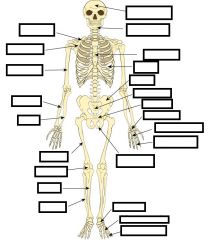
Name the Primary Bones in the Skeletal System
Purpose? |

Provides protection and support, allows body movements, produces blood cells, and stores minerals and fat. Consists of bones, associated cartilages, ligaments, and joints.
|
|
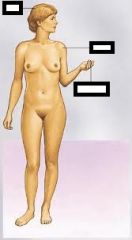
Name the Primary Components of the Integumentary System
Purpose? |

Provides protection, regulates temperature, prevents water loss, and helps produce vitamin D. Consists of skin, hair, nails, and sweat glands.
|
|

Name the Primary Muscles involved in the Muscular System
Purpose? |
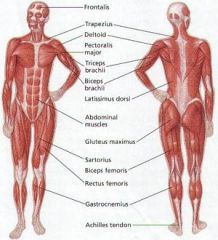
Produces body movements, maintains, posture, and produces body heat. Consists of muscles attached to the skeleton by tendons.
|
|

Name the primary systems involved in the Lymphatic System
Purpose? |

Removes foreign substances from the blood and lymph, combats disease, maintains tissue fluid balance, and absorbs fats from the digestive tract. Consists of the lymphatic vessels, lymph nodes, and other lymphatic organs.
|
|
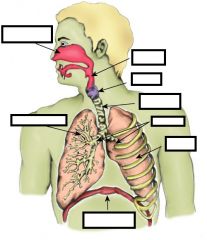
Name the primary organs in the respiratory system
Purpose? |

Exchanges oxygen and carbon dioxide between the blood and air and regulates blood pH. consists of the lungs and respiratory passages.
|
|
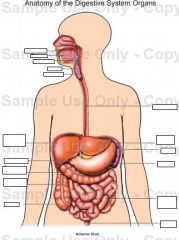
Name the primary organs involved in the digestive system
Purpose? |

Performs the mechanical and chemical processes of digestion, absorption of nutrients, and elimination of wastes. Consists of the mouth, esophagus, stomach, intestines, and accessory organs.
|
|
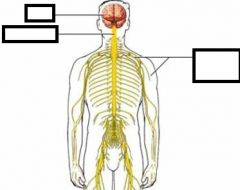
Name the main organs involved in the Nervous System
Purpose? |

A major regulatory system that detects sensations and controls movements, physiological processes, and intellectual functions. Consists of the brain, spinal cord, nerves, and sensory receptors.
|
|
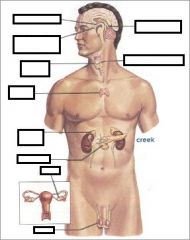
Name the primary organs in the Endocrine System
Purpose? |

A major regulatory system that influences metabolism, growth, reproduction, and many other functions. Consists of glands, such as the pituitary, that secrete hormones.
|
|
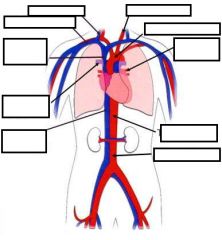
Name the primary organs involved in the cardiovascular system
Purpose? |

Transports nutrients, waste products, gases, and hormones throughout the body; plays a role in the immune response and the regulation of body temperature. Consists of the heart, blood vessels, and blood.
|
|
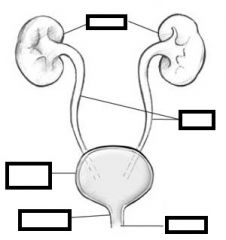
Name the primary organs involved in the Urinary System
Purpose? |

Removes Waste products from the blood and regulates blood pH, ion balance, and water balance. Consists of the kidneys, urinary bladder, and ducts that carry urine.
|
|
|
Name the primary organs involved in the FEMALE reproductive system.
Purpose? |
Produces oocytes and is the site of fertilization and fetal development; produces milk for the newborn; produces hormones that influence sexual function and behaviors. Consists of the ovaries, vagina, uterus, mammary glands, and uterine tube.
|
|
|
Name the primary organs involved in the MALE reproductive system.
Purpose? |
Produces and transfers sperm cells to the female and produces hormones that influence sexual functions and behaviors. Consists of the testes, ductus deferens, seminal vesicle, prostate gland, epididymis, and penis.
|
|
|
Negative Feedback
|

Negative feedback maintains homeostasis by resisting any deviation from set point and returning the body to a normal range.
1) A receptor monitors the value of a variable - blood pressure 2) Control center establishes the set point around the variable - brain 3) An effector changes the value of the variable to maintain homeostasis - heart Example: Blood Pressure |
|
|
Positive Feedback
|
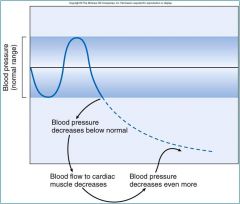
Less Common than Negative Feedback
When a value deviates from normal values, the system's response is to make the deviation even greater Ex: inadequate delivery of blood to cardiac (heart) muscle Ex: hemorrhage = blood pressure goes decreases because of losing blood, heart can’t work properly (heart beats even slower), thus causing blood pressure to decrease even further, etc. Ex: Estrogen surge during menstrual cycle, release of estrogen causes more release of estrogen Negative feedback is much more common than positive feedback |
|
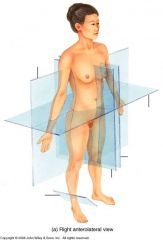
|

|
|

|

|
|
|
Ion Chemical Significance?
Ca 2+ Calcium |
Part of bones and teeth; functions in blood clotting, muscle contraction, release of neurotransmitters
|
|
|
Ion Chemical Significance?
Na + Sodium |
Membrane potentials, water balance
|
|
|
Ion Chemical Significance?
K + Potassium |
Membrane potentials
|
|
|
Ion Chemical Significance?
H + Hydrogen |
Acid-base balance
|
|
|
Ion Chemical Significance?
OH Hydroxide |
Acid-base balance
|
|
|
Ion Chemical Significance?
C l- Chloride |
Water balance
|
|
|
Ion Chemical Significance?
HCO3 - Bicarbonate |
Acid-base balance
|
|
|
Ion Chemical Significance?
NH4 + Ammonium |
Acid-base balance
|
|
|
Ion Chemical Significance?
PO4 3- Phosphate |
Part of bones and teeth; functions in energy exchange, acid-base balance
|
|
|
Ion Chemical Significance?
Fe 2+ Iron |
Red blood cell function
|
|
|
Ion Chemical Significance?
Mg 2+ Magnesium |
Necessary for enzymes
|
|
|
Ion Chemical Significance?
I - Iodide |
Present in thyroid hormones
|
|
|
ATP
|
Adenosine Triphosphate
Provides energy as a result of breakdown from ATP → ADP |
|
|
Neutral Solution
|
number H + = number OH -
|
|
|
Acidic Solution
|
number of H + > number of OH -
|
|
|
Basic (Alkaline) Solution
|
number of H + < number of OH -
|
|
|
Buffer
|
a chemical that resists changes in pH when either an acid or a base is added to a solution
|
|
|
ECF
|
Extracellular Fluid, makes up about 1/3 of the body's water
|
|
|
ICF
|
Intracellular Fluid, makes up about 2/3 of the body's water
|
|
|
Interstitial Fluid
|
Fluid that bathes the outside of cells, plasma leaks fluid into the interstitial space primarily through capillaries
|
|
|
Capillaries
|
the smallest of a body's blood vessels
|
|
|
Plasma
|
fluid part of the blood (extracellular)
|
|
|
Fluid Mosaic Model
|
Phospholipids form a double layer of molecules, a barrier between the inside and outside of the cell, gives it a liquid quality. Cholesterol within offers strength and flexibility. Proteins "float" freely throughout the membrane and are sometimes modified by carbohydrates. Proteins function as membrane channels carrying molecules.
|
|
|
Cation? Anion?
|
positive charged ion
|
|
|
Major Cations and Anions in ECF? Major Cations and Anions in ICF?
|
Extracellular fluid =
Cations: Sodium, Potassium, Calcium Anions: Chloride, Hydrogen Carbonate Intracellular fluid = Cations: Potassium Anions: Hydrogen Phosphate |
|
|
How are ion concentration differences maintained between the ECF and ICF?
|
Leaky pores and the sodium-potassium pumps.
Potassium tends to be INSIDE the cell Sodium tends to be OUTSIDE the cell |
|
|
Phospholipid structure?
|
Tails make up most of the lipids, which are made up of hydrocarbons
Tend to be Hydrophilic (water loving) Lipids like being with other lipids Lipids assemble together with tails pointed towards each other |
|
|
Cell membranes
|
Tend to be lipophilic (water fearing or hydrophobic)
|
|
|
Hydrophilic
|
water loving
|
|
|
Hydrophobic
|
water fearing, lipophilic
diffuse easily across the cell membrane |
|
|
Lipophilic
|
water fearing, hydrophobic
diffuse easily across the cell membrane |
|
|
Diffusion? Basics?
|
solutes move from a place of higher concentration to a place of lower concentration of that solute in solution.
Diffusion is random! Ex: perfume in a room WITH gradient Examples: Oxygen, carbon dioxide, chloride ions, urea Hydrophobic molecules diffuse easily across the cell membrane. Like diffuses like. Steroids are made of cholesterol (which is a lipid) therefore it diffuses across cell membranes. Ions DO NOT cross cell membranes |
|
|
Net Diffusion?
|
solutes move from a place of higher concentration to a place of lower concentration of that solute in solution.
Net Diffusion is HIGH → LOW Ex: More in "A" than in "B" |
|
|
Osmosis
|
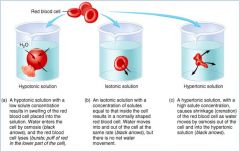
Osmosis can be thought of as the diffusion of water from an area of high water concentration to an area of low water concentration. Water wants to move where it has more stuff to dissolve.
|
|
|
Isotonic
|
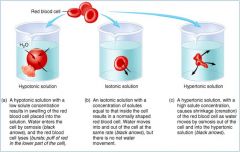
water plus salt (or a substance)
|
|
|
Hypotonic
|
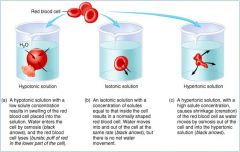
it has more solute inside the cell than outside
|
|
|
Hypertonic
|
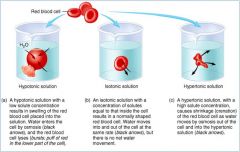
it has more solute outside of the cell than inside
|
|
|
Facilitated diffusion
|
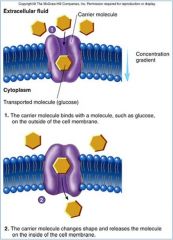
Facilitated Diffusion utilizes a protein in the cell membrane to transport solutes down their concentration gradients.
Ex: glucose WITH gradient no energy needed |
|
|
Primary Active Transport
|
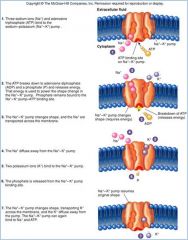
Primary Active Transport utilizes a protein to pump solutes against their concentration gradients. It moves low to high and requires additional energy (ATP).
Ex: Sodium out, Potassium in, ATP used up AGAINST gradient Ex: sodium, potassium, calcium, and hydrogen; amino acids |
|
|
Secondary Active Transport
|
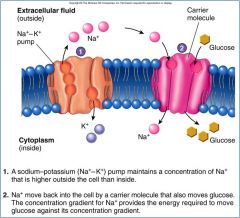
Secondary Active Transport involves the coupled transport of 2 or more solutes.
It requires indirect energy, which comes from the primary active transport. Something is always moving in the gradient and something is always moving against the gradient; usually sodium is moving down. AGAINST gradient by carriers EX: Glucose, amino acids |
|
|
Major Molecules in Cell Membrane?
|
Phospholipids and proteins.
Lesser: cholesterol and carbohydrates. |
|
|
Cell Membrane diffusion easy? What substances are found in the cell membrane?
|
small water-soluble molecules diffuse easily across, others must pass through membrane channels
molecules that are lipid-soluble, such as Oxygen, carbon dioxide, and steroids, pass through the phospholipids. enzymes, glycogen, and potassium ions are found inside the cell. sodium, calcium ,and chlorine are found outside the cell |
|
|
Which direction is sodium pumped? Potassium?
Why is this important? |
Sodium moves Up
Potassium moves Down Results in a higher concentration of sodium extracellularly and a higher concentration of potassium intracellularly. This is essential in maintaining membrane potential. |
|
|
Histology
|
microscopic study of tissue structure
|
|
|
Epithelium
|
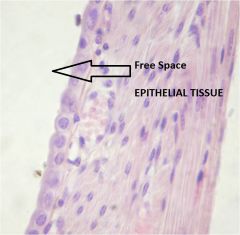
covers internal and external surfaces throughout the body. it also forms most glands.
No blood vessels in the epithelial tissue. Gets blood from the basement membrane. Purpose: protection, selective barrier, secretion, absorption, propulsion Identification: Open space |
|
|
Basement Membrane
|

Secreted partly by epithelial cells and partly by the cells of the underlying tissues. It consists of a meshwork of protein molecules with other molecules bound to them.
Has blood vessels Purpose: filter and barrier ex: prevent metastasis (moving of disease) Made of collagen and adhesives; acellular |
|
|
Cilia
|
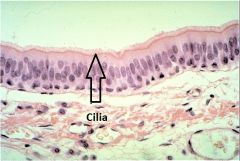
propel materials along the free surface of cells. The nasal cavity and trachea are lined with pseudostratified columnar ciliated epithelium.
Require energy cuz they are constantly beating |
|
|
Microvilli
|
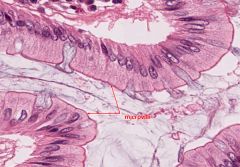
cylindrical extensions of the cell membrane that increase the free surface area. Normally many microvilli cover the free surface of each cell involved in absorption or secretion, such as the cells lining the small intestine or kidneys.
|
|
|
Tight Junctions
|
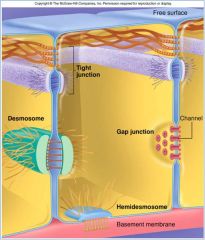
bind adjacent cells together and form permeability barriers. Tight junctions prevent the passage of materials between epithelial cells because they completely surround each cell, similar to the way a belt surrounds the waist. materials must pass through the cells, so they're regulators.
|
|
|
Gap Junctions
|
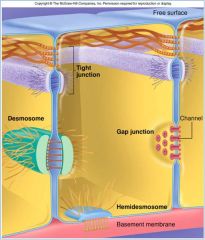
Small channels that allow small molecules and ions to pass from one epithelial cell to another. Most epithelial cells are connected to one another by gap junctions, and researchers believe that molecules or ions moving through the gap junctions act as communication signals to coordinate the activities of cells.
|
|
|
Simple Squamous Epithelium
|
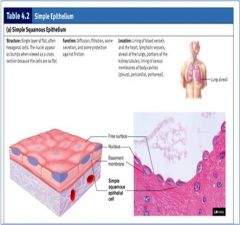
Location: air sacs (alveoli) of lungs and inner linings of the heart and blood vessels
Purpose: Diffusion and Filtration - It is found lining surfaces of passive transport or gasses. |
|
|
Simple Cuboidal Epithelium
|
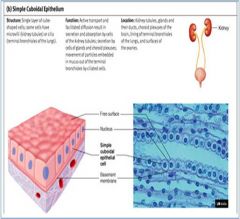
Location: Kidney tubules, thyroid gland, liver, and ducts of salivary glands
Function: Secretion, excretion, absorption |
|
|
Simple Columnar Epithelium
|
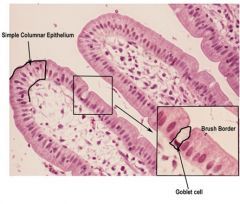
Location: Anywhere that requires absorption.
Nonciliated: uterus, stomach, and intestines. Ciliated: Uterine tubes Function: Protection, Secretion, and Absoption |
|
|
Pseudostratified Columnar Epithelium
|
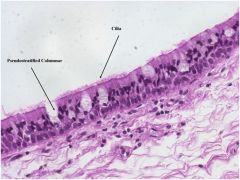
Location: Linings of the Upper respiratory tubes
Function: trap and move pollutants to the mouth where they are swallowed |
|
|
Stratified Squamous Epithelium
|
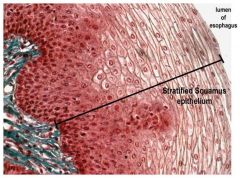
Location: Keratinized - Epidermis of the skin
Nonkeratinized - linings of the oral cavity, esophagus, vagina, and anal canal |
|
|
Transitional Epithelium
|
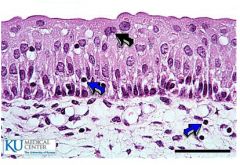
Location: Line the urinary bladder, ureters, and part of the urethra
Function: distention or fluctuation |
|
|
Goblet Cells
|
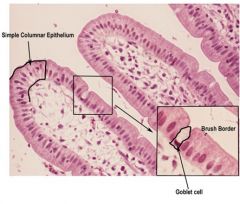
modified columnar epithelial cells that synthesize and secrete mucous
|
|
|
Endocrine Glands
|
No ducts
Empty secretions into the blood (Hormones) Includes: Thyroid gland and insulin-secreting portions of the pancreas |
|
|
Connective Tissue
|
found throughout body.
It is usually characterized by large amounts of extracellular material that separates cells from one another (Extracellular Matrix) Functions: Enclosing tissues, Support and movement, Energy storage, Cushioning and insulation, Protection |
|
|
Extracellular Matrix
|
Extracellular material that separates cells (connective Tissue).
Major Components: protein fibers, ground substance consisting of nonfibrous protein and other molecules and fluid |
|
|
Exocrine Glands
|
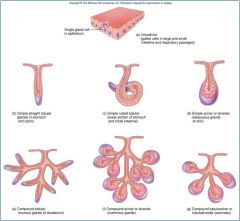
Have Ducts
simple or compound or tubular Includes: sweat glands and sebaceous glands |
|
|
Collagen
|
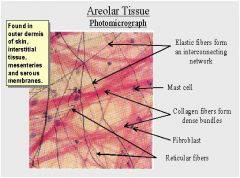
Resemble microscopic ropes, flexible but resist stretching
|
|
|
Ground Substance
|
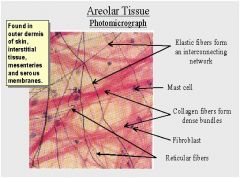
Shapeless background against which cells and collagen fibers can be seen
|
|
|
Elastin
|

have a structure similar to that of coiled metal bed springs; after being stretched, they can recoil to their original shape
|
|
|
Proteoglycans
|
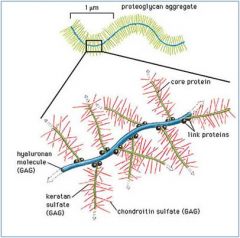
resemble the limbs of pine trees, with proteins forming the branches
(top is tropocollagen) |
|
|
-blasts
|
produce matrix
|
|
|
-cytes
|
maintain matrix
|
|
|
-clasts
|
break down matrix for remodeling
|
|
|
macrophages
|
immune; white blood cells (phagocytes) that eat
|
|
|
mast cells
|
immune; allergy preventers, release histamine and heparin
|
|
|
Areolar Connective
|
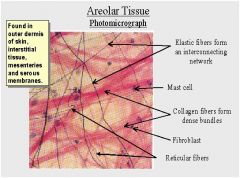
Location: around body organs
Function: binds skin to deeper organs Makes up membranes Loose packing support, and nourishment for the structures with which it is associates |
|
|
Adipose Connective
|
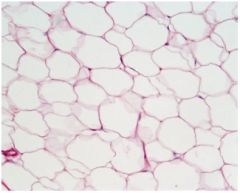
Locations: subcutaneous layer; around kidneys and heart; yellow bone marrow; breasts
Function: Packing material, thermal insulator, energy storage, and protection of organs against injury from being bumped or jarred |
|
|
Reticular Connective
|

Location: spleen; thymus; lymph nodes; red bone marrow
Function: forms a soft skeleton to support lymphatic organs, also holds adipose tissue together |
|
|
Dense Regular Connective
|
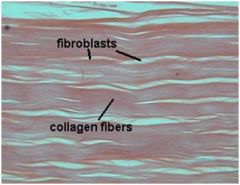
Location: Ligaments and Tendons
Functions: Withstanding great pulling forces exerted in the direction of fiber orientation due to great tensile strength and stretch resistance |
|
|
Dense Irregular Connective
|
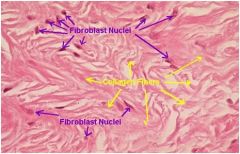
Location: Dermis, Heart Valves (AEORTA), periosteum on bone
Function: strength and stretch resistance |
|
|
Elastic Connective
|
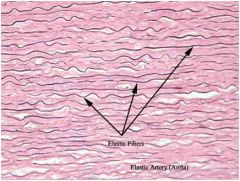
Locations: larger artery walls; vocal cords; ligaments between vertebrae
Function: Capable of Stretching and recoiling like a rubber band with strength in the direction of fiber orientation |
|
|
Hyaline Cartilage
|
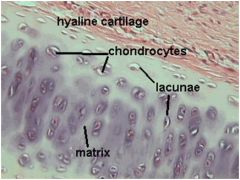
Locations: Nasal Septum, larynx, costal cartilage, ends of long bones, fetal skeleton
Functions: Allows growth of long bones; provides rigidity with some flexibility in the trachea, bronchi, ribs and nose; forms rugged, smooth yet somewhat articulated surfaces; forms the embryonic skeleton |
|
|
Fibrocartilage
|
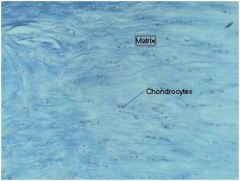
Locations: between vertebrae; between pubic bones; pads (meniscus) in knee
Functions: More collagen than hyaline; somewhat flexible and capable of withstanding considerable pressure, connects structures subjected to great pressure |
|
|
Elastic Cartilage
|
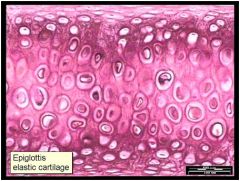
Locations: outer ear; epiglottis
functions: contains elastin and collagen and proteoglycans; provides rigidity with even more flexibility than hyaline cartilage because elastic fibers return to their original shape after being stretched |
|
|
Compact Bone
|
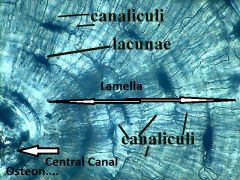
Locations: Bone Shafts (Sides of Bones), beneath periosteum
Functions: provides great strength and support and protects internal organs such as the brain, bone also provides attachment sites for muscles and ligaments |
|
|
Spongy (Cancellous) Bone
|
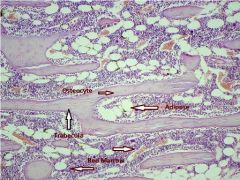
locations: ends of long bones; inside flat and irregular bones
Functions; holds marrow, provides strength and support |
|
|
Blood (Liquid) Connective
|
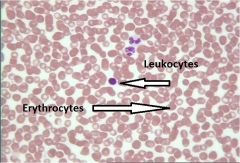
Locations: Lumens of blood vessels; heart chambers
Functions: Transports oxygen, carbon dioxide, hormones, nutrients, waste products, and other substances protects the body from infection and is involved in temperature regulation. |
|
|
Do blood vessels extend into epithelium? How does epithelial tissue exchange gasses, nutrients and wastes?
|
Blood vessels do not extend from the underlying tissues into epithelium, so gases and nutrients that reach the epithelium must diffuse across the basement membrane from the underlying tissues, where blood vessels are abundant. Waste products produced diffuse across the basement membrane to blood vessels.
|
|
|
Describe the changes which occur to epithelium lining the respiratory tract in long-term smokers. How does this lead to smoker's cough?
|
Delicate pseudostratified columnar epithelium, which performs a cleaning function by moving mucus and debris from the passageways, is replaced by stratified squamous epithelium, which is more resistant to irritation but does not perform a cleaning function. also, lung cancer most often results from changes in epithelial cells in the lung passageways of smokers. Changes are used to identify cancer. Smokers often cough because they have to in order to get rid of mucous and debris that used to be removed by cilia.
|
|
|
Are blood vessels present in connective tissue?
|
yes, erythrocytes are generally present in connective tissue.
|
|
|
How does collagen fiber help tissues?
|
it provides added strength and durability.
|
|
|
Muscle Tissue
|
Characterized by elongated cells, often called muscle fibers, that can contract to create movements
Attached to skeleton, but also components of internal organs Generates body heat through movement |
|
|
Skeletal Muscle Tissue
|
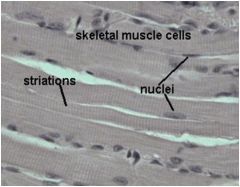
Voluntary Control, Striated
Locations: Attached to bones via tendons, tongue, facial muscles, and voluntary sphincters Functions: body movement, maintaining posture, breathing, speaking, controlling waste eliminations, and protection |
|
|
Smooth Muscle Tissue
|

Involuntary, non-striated
Locations: visceral organs, the iris, blood vessels, respiratory tubes, attached to hair follicles Functions: visceral organs, controlling pupil size, blood flow, and airflow, and creating "goose bumps" if we are too cold or frieghtened |
|
|
Cardiac Muscle Tissue
|
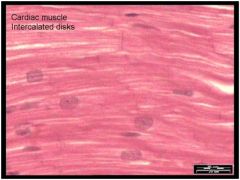
Involuntary, Striated
Locations: Only in heart wall Functions: Pumping Blood |
|
|
Neurons
|
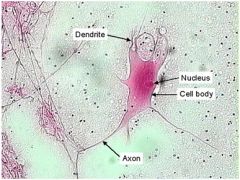
Contain a cell body with the nucleus and most of the cytoplasm, and cellular processes that extend from the cell body
Cellular processes include one to many dendrites and a single axon (nerve fiber) Functions: Considered excitable cells because they can exhibit signals called action potentials (nerve impulses) along the neuron to another neuron or a muscle or gland |
|
|
Neuroglia
|
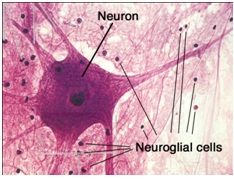
Glial Cells
More abundant than neurons Cannot conduct nerve impulses Functions: they have important supportive and protective functions for neurons |
|
|
Integumentary System
|
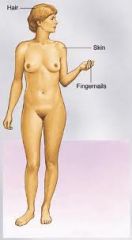
Consists of the skin and accessory structures, such as hair, glands, and nails
Functions: Protection, sensation, vitamin d production, temperature, regulation, excretion |
|
|
Epidermis
|
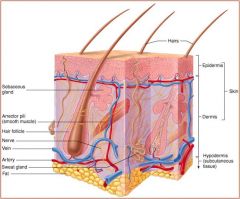
most superficial layer of skin, layer of epithelial on the dermis, prevents water loss and resists abrasion, stratified squamous epithelium, new cells produced by mitosis.
|
|
|
Dermis
|
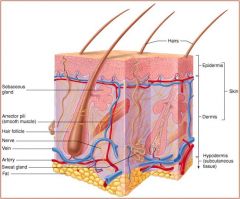
layer of dense connective tissue, on average the dermis is 10-20 times thicker than the epidermis, responsible for structural strength of skin, rests on hypodermis which connects skin to muscle
|
|
|
Subcutaneous Fat
|
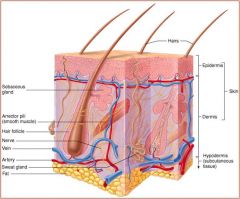
a fat layer found in the hypodermis, the base layer of skin. It is connective tissue to muscle.
|
|
|
Keratinization
|
as new cells form, they push older cells to the surface, where they slough, or flake off. The outermost cells protect the cells underneath, and the deeper, replicating cells replace cells lost from the surface. During their movement, the cells change shape and chemical composition. The cells are filled with the protein keratin, which makes them hard. As keratinization proceeds, epithelial cells eventually die and produce an outer layer of dead, hard cells that resists abrasion and forms a permeability barrier.
|
|
|
Stratum Corneum
|

The most superficial stratum of the epidermis. it consists of dead squamous cells filled with keratin. Keratin gives the stratum corneum its structural strength. The stratum corneum cells are also coated and surrounded by lipids, which help prevent fluid loss through the skin. It consists of 25 or more layers of dead squamous cells joined by desmosomes. Excessive stratum corneum cells sloughed from the surface of the scalp are called dandruff. in skin subjected to friction, the number of layers in the stratum corneum greatly increases, producing a thickened area called a callus.
keratinocytes Apical Layer |
|
|
Stratum basale
|
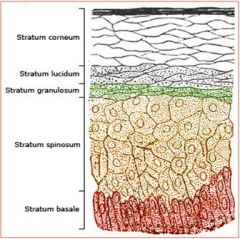
deepest stratum, consists of cuboidal or columnar cells that undergo mitotic divisions about every 19 days. one daughter cell becomes a new stratum basale cell and can divide again. The other daughter cell is pushed toward the surface, a journey that takes about 40-56 days. As cells move to the surface, changes in the cells produce intermediate strata.
Made of cuboidal or columnar tissue. Takes almost 3 months to have all knew skin (reach surface) keratinocytes "Germinativum" Basal Layer |
|
|
Mitosis
|
when a eukaryotic cell undergoes self division into two different cells
|
|
|
Dermal Papillae
|
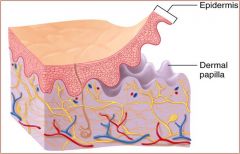
Contain many blood vessels that supply the overlying epidermis with nutrients, remove waste products, and help regulate body temperature. The dermal papillae int he palms of the hands, the soles of the feet and the tips of the digits are arranged in parallel, curving ridges that shape the overlying epidermis into fingerprints and footprints. The ridges increase friction and improve the grip of the hands and feet.
|
|
|
Cleavage lines
|
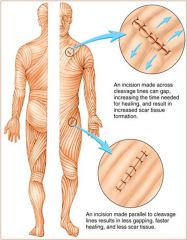
collagen fibers of the dermis are oriented in many different directions and can resist stretch. However, more collagen fibers are oriented in some directions than in others. This produces cleavage lines, or tension lines, in the skin, and the skin is most resistant to stretch along these lines. it is important for surgeons to be aware of cleavage lines. An incision made across the cleavage lines is likely to gap and produce considerable scar tissue, but an incision made parallel with the lines tends to gap less and produce less scar tissue.
|
|
|
Melanocytes
|

melanin is produced by melanocytes, which are irregularly shaped cells with many long processes that extend between the epithelial cells of the deep part of the epidermis.
|
|
|
Melanin
|
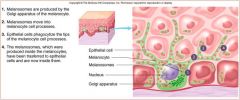
"black", group of pigments primarily responsible for skin, hair, and eye color. Most melanin molecules are brown to black pigments, but some are yellowish or reddish. Melanin provides protection against ultraviolet light from the sun. Large amounts of melanin form freckles or moles in some regions of the skin, as well as darkened areas in the genitalia, the nipples and the circular areas around the nipples. Other areas, such as the lips, palms of the hands, and soles of the feet, contain less melanin. melanin production is determined by genetic factors exposure to light, and hormones.
|
|
|
Albinism
|
recessive genetic train that causes a deficiency or an absence of melanin. Albinos have fair skin, white hair, and unpigmented irises in the eyes.
|
|
|
Hair follicle
|

hair arises from a hair follicle, an extension of the epidermis that originates deep in the dermis. The shaft of hair protrudes above the surface of the skin, whereas the root and hair bulb are below the surface.
|
|
|
Hair Bulb
|
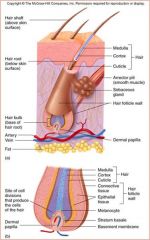
below the surface. hair is produced in the hair bulb, which rests on a dermal papilla. Blood vessels within the papilla supply the hair bulb with the nourishment needed to produce the hair. Hair is produced in cycles.
|
|
|
Male pattern Baldness
|
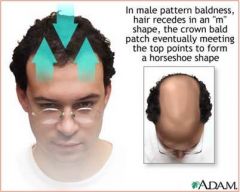
alothough many of the hair follicles are lost, some remain and produce a very short, transparent hair, which for practical purposes is invisible. These changes occur when male sex hormones act on the hair follicles of men who have the genetic predisposition for pattern baldness.
|
|
|
Sabaceous glands
|
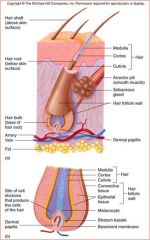
simple, branched acinar glands. Most are connected by a duct to the superficial part of the hair follicle.
|
|
|
Sebum
|
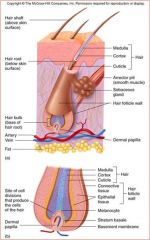
an oily, white substance rich in lipids. The sebum lubricates the hair and the surface of the skin, which prevents drying and protects against some bacteria.
Exocrine |
|
|
Apocrine Sweat Glands
|
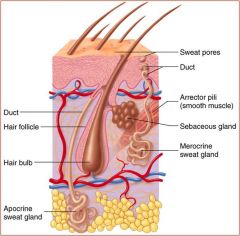
Simple, coiled, tubular glands, that produce a thick secretion rich in organic substances. They open into hair follicles, but only in the armpits and genitalia. Apocrine sweat glands become active at puberty because of the influence of sex hormones. The organic secretion, which is essentially odorless when released is quickly broken down by bacteria into substances responsible for what is commonly known as body odor.
Exocrine |
|
|
Eccrine Sweat Glands
|
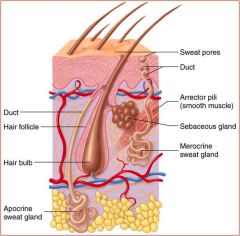
simple, coiled, tubular glands located in almost every part of the skin but most numerous in the palms and soles. They produce a secretion that is mostly water with a few salts. Eccrine sweat glands have ducts that open onto the surface of the skin through sweat pores. When the body temperature starts to rise above normal levels, the sweat glands produce sweat, which evaporates and cools the body. Sweat can also be released in the palms, sole, armpits, and other replaces because of emotional stress. Emotional sweating is used in lie detector tests because sweat gland activity usually increases when a person tells a lie. Such tests can detect even small amounts of sweat because the salt solution conducts electricity and lowers the electrical resistance of the skin.
|
|
|
Vitamin D
|
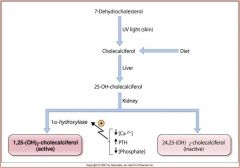
formed when exposed to ultraviolet light. The vitamin is carried by the blood to the liver, where it is modified and then to the kidneys, where it is modified further to form active vitamin d. If exposed to enough ultraviolet light, humans can produce all the vitamin d they need. However many people need to ingest vitamin d as well because clothing and indoor living reduce their exposure to UV Light. Fatty fish and vitamin d fortified milk are the best sources. Vitamin d stimulates the intestines to absorb calcium and phosphate, the substance necessary for normal bone growth and normal muscle function.
|
|
|
Edema
|
Swelling
|
|
|
Malignant Melanoma
|
rare form of skin cancer that arises from melanocytes, usually in a preexisting mole. A mole is an aggregation, or "nest" of melanocytes. The melanoma can appear as a large, flat, spreading lesion or as a deeply pigmented nodule. Metastasis is common, and unless diagnosed and treated early in development, this cancer is often fatal.
|
|
|
1st, 2nd, and 3rd degree burns
|

1. Involve only the epidermis and are red and painful. Slight edema or swelling, may be present. Heals in a week.
2. Damages both the epidermis and the dermis. if dermal damage is minimal symptoms include redness, pain, edema, and blisters. healing takes 2 weeks. if deep in the dermis, may appear red, tan or white; can take several months to heal and might scar. 3. Epidermis and the dermis are completely destroyed, and recovery occurs from the edges of the burn wound. Third degree are often surrounded by areas of first and second. Although first and second areas are painful the region of third is usually painless because sensory receptors in the epidermis and dermis have been destroyed. may appear white, tan, brown, black or deep cherry red. Doctors may use skin grafting to heal. |
|
|
What are the major functions of the integumentary system?
|
Protection
Sensation Vitamin D Production Temperature Regulation Excretion |
|
|
What function is the epidermis best adapted for? The dermis?
|
epidermis prevents water loss and resists abrasion.
dermis is responsible for most of the skin's structural strength. (collagen and elastic fibers) |
|
|
Describe how skin grows? Which layers are involved? What is the role of keratinization?
|
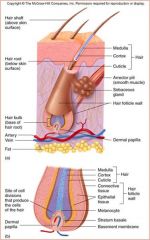
New cells are produced by mitosis. As new cells form, they push older cells tot he surface, where they slough, or flake off. The outermost cells underneath, and the deeper, replicating cells replace cells lost from the surface. During their movement, the cells change shape and chemical composition. The cells are filled with the protein keratin (keratinization), which makes them hard. As keratinization proceeds, epithelial cells eventualy die and produce an outer layer of dead, hard cells that resist abrasion and form a permeability barrier. Specific layers of strata are involved (Stratum Basale to Stratum Corneum).
|
|
|
What kinds of substances could easily pass through the skin by diffusion?
|
Lipophilic or Hydrophobic
|
|
|
What kind of tissue is the dermis? What structures and cell types are present within the dermis? Are blood vessels present?
|
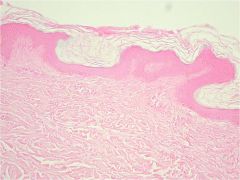
The dermis is composed of dense collagenous connectie tissue containing fibroblasts, fat cells, and macrophages. nerves, hair follicles, smooth muscles, glands, and lymphatic vessels extend into the dermis Collagen and elastic fibers are responsible for the structural strength of the dermis.
Blood vessels are present. |
|
|
With respect to cleavage line orientation, which direction would be best for making an incision? Why?
|
An incision made across the cleavage lines is likely to gap and produce cinsiderable scar tissue, but an incision made parallel with the lines tends to gap less and produce less scar tissue.
|
|
|
How do epithelial cells in the skin acquire melanin? What factors account for skin color? Which of these increase melanin production?
|
Factors that determine skin color include pigments in the skin, blood circulating through the skin, and the thickness of the stratum corneum. Melanin is the group of pigments primarily responsible for skin, hair, and eye color. melanin is produced by melanocytes which are irregularly shaped cells with many long processes that extend between the epithelial cells of the deep part of the epidermis. The Golgi apparatuses of the melanocytes package melanin into vesicles called malanosomes which move into the cell process of the melanocytes. Epithelial cells phagocytize the tips of the melanocyte cell processes, thereby acquiring melanosomes.
Melanin production is determined by genetic factors exposure to the light, and hormones. Exposure to ultraviolet light in sunlight stimulates melanocytes to increase melanin production. The result is a tan. |
|
|
What type of tissue is hair composed of? How does it grow? What is responsible for male pattern baldness?
|
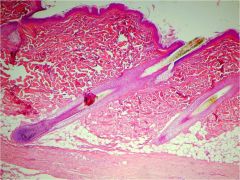
Hair is produced in the hair bulb, which rests on a dermal papilla. Blood vessels within the papilla supply the hair bulb with the nourishment needed to produce the hair. Hair is produced in cycles. During the growth stage it is formed by epithelial cells within the hair bulb. These cells, like the cells of the stratum basale in the skin, divide and undergo keratinization. The hair grows longer as these cells are added to the base of the hair within the hair bulb. During the resting stage, growth stops. when the next growth stage begins, a new hair is formed and the old hair falls out. Eyelashes 30 days, rest for 105 days. Scalp 3 years, rest for 1-2 years.
In baldness, some hair remains and produce a very short, transparent hair, which for practical purposes is invisible. These changes occur when male sex hormones act on the hair follicles of men who have the genetic predisposition for pattern baldness. DHT may destroy hair follicles (a converted form of testosterone). Finasteride inhibits DHT synthesis. |
|
|
What is the role of the skin in vitamin D synthesis? Give one example why having adequate levels of vitamin D in the body is important.
|
Adequate levels of vitamin D are necessary because vitamin D stimulates the intestines to absorb calcium and phosphate, the substances necessary for normal bone growth and normal muscle function.
|
|
|
How is body temperature homeostasis regulated by blood flow in the skin?
|
Normal body temperature is maintained at = 37 C
Regulation of body temperature is important because the rate of chemical reactions within the body can be increased or decreased by changes in the body temperature. Even slight changes in temperature can make enzymes operate less efficiently and disrupt the normal rates of chemical changes in the body. To cool, blood vessesl in the dermis dilate and enabel more blood to flow within the skin, thus transferring heat from deeper tissues to the skin where the heat is lost by radiation (infrared energy), convection (air movement), or conduction (direct contact with an object). Sweat that spreads over the surface of the skin and evaporates also carries away heat and reduces body temperature. To heat, constriction of dermal blood vessels reduce blood flow to the skin. Thus less heat is transferred from deeper structures to the skin, and heat loss is reduced. however with smaller amounts of warm blood flowing through the skin, the skin temperature decreases. if the skin temperature drops below 15 C, dermal blood vessels dilate. |
|
|
Explain how extensive burns can be immediately life-threatening.
|
Increased permeability of capillaries results in fluid and ions from the burn wound traveling into tissue spaces. The loss of fluid decreases blood volume, which decreases the heart's ability to pump blood. The resulting decrease in blood delivery to tissues can cause tissue damage, shock and even death. infections are the major cause of death for burn victims. Depression of the immune system during the first or second week after injury contributes the high infection rate. Venous thrombosis can also form as another complication. Clots occur regularly at damaged tissue, but can occur also in the veins halting blood flow.
|
|
|
Hypodermis
|
Subcutaneous fat, makes up about 1/2 body fat, used to estimate % body fat, It's fatty connective tissue
Areolar + Adipose Tissue |
|
|
Vitiligo
|
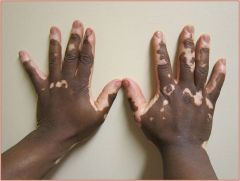
may result from autoimmune destruction of melanocytes
|
|
|
What can you do if you do not have the correct amount of melanin for your geographical location?
|
D3 supplements, diet
or Shading and sunscreens |
|
|
Ringworm
|
Fungal infection that produces patchy scaling and inflammatory response in the skin
|
|
|
Eczema and Dermatitis
|
Inflammatory conditions of the skin caused by allergy, infection, poor circulation, or exposure to chemical or environmental factors
|
|
|
Psoriasis
|
Chronic skin disease characterized by thicker than normal epidermal layer (stratum corneum) that sloughs to produce large, silvery scales; bleeding may occur if the scales are scraped away
|
|
|
Impetigo - Bacterial Infection
|
Small blisters containing pus; easily rupture to forma thick, yellowish crust; usually affects children
|
|
|
Decubitus ulcers (Bedsores or Pressure sores) - Bacterial Infection
|
Develop in people who are bedridden or confined to a wheelchair; compression of tissue and reduced circulation result in destruction of the hypodermis and skin, which later become infected by bacteria, forming ulcers.
|
|
|
Rubeola (measles) - Viral Infections
|
Skin lesions; caused by a virus contracted through the respiratory tract; may develop into pneumonia or infect the brain causing damage.
|
|
|
Rubella (German Measles) - Viral Infections
|
Skin lesions; usually mild viral disease contracted through the respiratory tract; may be dangerous if contracted during pregnancy because the virus can cross the placenta and damage the fetus.
|
|
|
Varicella (Chicken Pox) - Viral Infections
|
Skin lesions; usually mild viral disease contracted through the respiratory tract
|
|
|
Shingles - Viral Infections
|
Painful skin lesions that can recur when the dormant virus is activated by trauma, stress, or another illness; caused by the chickenpox virus after childhood infection.
|
|
|
Cold Sores - Viral Infections
|
Skin lesions; caused by herpes simplex I virus; transmitted by oral or respiratory routes; lesions recur
|
|
|
Genital Herpes - Viral Infections
|
Genital lesions; caused by herpes simplex II Virus; transmitted by sexual contact
|
|
|
Hydroxyapatite
|
Hydroxyapatite – Most of the mineral in bone is in the form of calcium phosphate
Hydroxyapatite = concrete Collagen = flexible rebar |
|
|
Diaphysis
|
Diaphysis = central shaft of the bone
|
|
|
Epiphysis
|
Epiphysis = ends of bone
|
|
|
Epiphyseal plate/line
|
Epiphyseal plate/line = growth plate, composed of cartilage, between each epiphysis and the diaphysis. This is where the bone grows in length. When bone growth stops, the cartilage of each epiphyseal plate is replaced by bone and becomes an epiphyseal line.
|
|
|
Red Marrow and Yellow Marrow
|
Red marrow and Yellow Marrow – resides in medullary cavity in the diaphysis, and smaller cavities in the epiphyses of long bones.
Red marrow consists of blood-forming cells and is the only site of blood formation in adults. Children have more red marrow than adults (growth). Yellow marrow replaces red, it contains mostly adipose tissue. |
|
|
Periosteum
|
Periosteum – Most of the outer surface of bone is covered by dense connective tissue which is HIGHLY vascularized (blood vessels) and lots of nerves; outer layer is tougher
|
|
|
Endosteum
|
Endosteum – the surface of the medullary cavity is lined with a thinner connective tissue membrane; not vascularized
|
|
|
Compact Bone
|
Compact bone – blood vessels in bone matrix (osteons) are only found in compact bone; forms most of the diaphysis of long bones and the thinner surfaces of all other bones.
|
|
|
Osteoblasts
|
The periosteum and endosteum contain osteoblasts, which function in the formation of bone, as well as in the repair and remodeling of bone. When osteoblasts become surrounded by matrix, they are referred to as osteocytes.
|
|
|
Osteocytes
|
When osteoblasts become surrounded by matrix, they are referred to as Osteocytes.
|
|
|
Lamellae
|
Bone is formed in thin sheets of extracellular matrix called lamellae, which osteocytes located between the lamellae within spaces called lacunae.
|
|
|
Canaliculi
|
Cell processes extend from the osteocytes across the extracellular matrix of the lamellae within tiny canals called canaliculi.
|
|
|
Spongy Bone (cancellous)
|
consists of a lacy network of bone with many small marrow-filled spaces.
It is located mainly in the epiphyses of long bones. It forms the interior of all other bones. Spongy bone consists of delicate interconnecting rods or plates of bone call trabeculae, which resemble scaffolding, the trabeculae add strength to a bone without the added weight that would be present if the bone were solid mineralized matrix. The spaces between are filled with marrow. |
|
|
Central Canal (Haversian Canal)
|
Blood vessels that run parallel to the long axis of the bone are contained within the central canals. Each central canal, with the lamellae and osteocytes surrounding it, is called an osteon, or haversian system. Most of the lamellae of compact bone are organized into sets of concentric rings, with each set surrounding a central canal.
|
|
|
Osteon
|
Each central canal, with the lamellae and osteocytes surround it, is called an osteon or haversian system. Each osteon, seen in cross section, looks like a microscopic target, with the central canal as the "bull's eye". Osteocytes, located in lacunae, are connected to one another by cell processes in canaliculi. The canaliculi give the osteon the appearance of having tiny cracks within the lamellae.
|
|
|
Trabeculae
|
delicate interconnecting rods or plates of bone, resmble the beams or scaffolding of a building. The trabeculae add strength to a bone without the added weight. Spaces are filled with marrow. Each trabecula consists of several lamellae with osteocytes between them. No blood vessels penetrate and no canals.
|
|
|
Ossification
|
Ossification is the formation of bone by osteoblasts. After an osteoblast becomes completely surrounded by bone matrix, it becomes a mature bone cell, or osteocyte. Bone formation that occurs within connective tissue membranes its called intramembranous ossification, and bone formation that occurs inside cartilage is called endochondral ossification.
|
|
|
Intramembranous Ossification
|
Intramembranous ossification occurs when osteoblasts begin to produce bone in connective tissue membranes. This occurs primarily in the bones of the skull. Osteoblasts line up on the surface of connective tissue fibers and begin depositing bone matrix to form trabeculae. Process begins in "ossification centers"; usually two or more centers exist in each flat skull bone, and the skull bones result from fusion as they enlarge.
Mostly found in Fetal Skulls |
|
|
Endochondral Ossification
|
The bones at the base of the skull and most of the remaining skeletal system develop through the process of endochondral ossification from cartilage models. The cartilage models have the general shape of the mature bone. During endochondral ossification, cartilage cells, called chondrocytes, increase in number, enlarge, and die. Then the cartilage matrix becomes calcified. As this process is occurring in the center of the cartilage model, blood vessels accumulate in the perichondrium. The presence of blood vessels in the outer surface of future bone causes some the unspecified connective tissue cells on the surface to become osteoblasts.
|
|
|
Chondrocytes
|
During endochondral ossification, cartilage cells, called chondrocytes, increase in number, enlarge, and die. Then the cartilage matrix becomes calcified.
|
|
|
Bone Collar
|
As the osteoblasts are laying down bone on either the calcified cartilage or old existing bone they form the first outer layer of new bone called the bone collar, which is then filled in.
|
|
|
Bone Remodeling
|
Bone remodeling involves the removal of existing bone by osteoclasts and the deposition of new bone by osteoblasts. Bone remodeling occurs in all bone. Remodeling is responsible for changes in bone shape, the adjustment of bone to stress, bone repair, and calcium ion regulation in the body fluids. Remodeling is also involved in bone growth when newly formed spongy bone in the epiphyseal plate forms compact bone. A long bone increasses in length and diameter as new bone is deposited on the outer surface and growth occurs at the epiphyseal plate. At the same time, bone is removed from the inner, medullary surface of the bone. As the bone diameter increases, the thickness of the compact bone relative to the medullary cavity tends to remain fairly constant. If the size of the medullary cavity did not also increase as bone size increases, the compact bone of the diaphysis would become thick and very heavy.
Calcium is regulated by; removal from bones when blood calcium levels decrease, and it is deposited when dietary calcium is adequate. This is controlled by hormones. |
|
|
Bone Remodeling
|
Bone remodeling involves the removal of existing bone by osteoclasts and the deposition of new bone by osteoblasts. Bone remodeling occurs in all bone. Remodeling is responsible for changes in bone shape, the adjustment of bone to stress, bone repair, and calcium ion regulation in the body fluids. Remodeling is also involved in bone growth when newly formed spongy bone in the epiphyseal plate forms compact bone. A long bone increases in length and diameter as new bone is deposited on the outer surface and growth occurs at the epiphyseal plate. At the same time, bone is removed from the inner, medullary surface of the bone. As the bone diameter increases, the thickness of the compact bone relative to the medullary cavity tends to remain fairly constant. If the size of the medullary cavity did not also increase as bone size increases, the compact bone of the diaphysis would become thick and very heavy.
Calcium is regulated by; removal from bones when blood calcium levels decrease, and it is deposited when dietary calcium is adequate. This is controlled by hormones. |
|
|
Parathyroid Hormone
|
PTH is secreted from the parathydoid glands when blood calcium levels are too low, stimulates increased bone breakdown and increased blood calcium levels by indirectly stimulating osteoclast activity. PTH increases calcium uptake from the urine in the kidney. Additionally, PTH stimulate the kidneys to form active vitamin D, which increases calcium absorption from the small intestine. Decreasing blood calcium levels stimulate PTH secretion.
|
|
|
Synovial Fluid
|
A complex mixture of polysaccharides, proteins, fat, and cells. Synovial fluid forms a thin, lubricating film covering the surfaces of the joint. In certain synovial joints, the synovial membrane many extend as a pocket or sac called a bursa.
|
|
|
Osteoporosis
|
Osteoporosis, or porous bone, results from reduction in the overall quantity of bone matrix. It occurs when the rate of bone reabsorption exceeds the rate of bone formation. The loss of bone mass makes bones so porous and weakened that they become deformed and prone to fracture.
In postmenopausal women, decreased production of the female sex hormone estrogen can cause osteoporosis. The degeneration occurs mostly in spongy bone, especially in the vertebrae of the spine and the bones of the forearm. Finally, osteoporosis can result from inadequate exercise or disuse caused by fractures or paralysis. Increased dietary calcium and vitamin D can increase calcium uptake and promote bone formation. Exercise helps, or estrogen replacement therapy decreases osteoclast activity, which reduces bone loss. Dual-emission X-ray absorptiometry (DXA, previously DEXA) is a means of measuring bone mineral density (BMD). Two X-ray beams with differing energy levels are aimed at the patient's bones. When soft tissue absorption is subtracted out, the BMD can be determined from the absorption of each beam by bone. Dual-energy X-ray absorptiometry is the most widely used and most thoroughly studied bone density measurement technology (Wikipedia). |
|
|
What are the major functions of the skeletal system?
|
Support
Protection Movement Storage Blood Cell Production |
|
|
What type of tissue is bone tissue? Describe the composition of the bone matrix. What would it be like if all of the mineral were removed? What if all of the collagen were removed?
|
Bone is made up of either compact or spongy Bone. But mostly it consists of an extracellular Matrix.
Hydroxyapatite: bone mineral composed of calcium phosphate crystals (This is like the concrete) Collagen (like the flexible rebar) If all the mineral were removed it would be super flexible If all the collagen were removed it would be really rigid. |
|
|
Describe how a long bone, such as the femur, would differ between a young person and an adult.
|
Young:
Mostly Spongy Bone Tons of Red Marrow (for blood cell productions) Epiphyseal plates are not closed yet - still growing Adults; Mostly Compact (though there is Spongy) Mostly yellow marrow (used to hold fatty marow, for minerals) Epiphyseal Plates have closed now called the Epiphyseal Lines |
|
|
Describe the major histological features of compact and spongy bone.
|
The periosteum and endosteum contain osteoblasts, which function in the formation of bone. When they are surrounded by matrix they are referred to as osteocytes.
Bone is formed in thin sheets of extracellular matrix called lamellae, with osteocytes located between the lamellae within spaces called lucunae. Cell processes extend from the osteocytes across the extracellular matrix of the lamellae within tiny canals called canaliculi. There are two major types: Compact bone is mostly solid matrix and cells. Compact bone has osteons or haversian systems with a central canal at the center. These osteons are built around blood vessels that run parallel to the axis and can provide nutrients. Spongy bone consists of a lacy network of bone with many small marrow-filled spaces. The interconnecting plates of spongy bone is called trabeculae, and trabeculae do not have blood vessels penetrating it. Marrow fills the spaces between the trabeculae. |
|
|
Briefly outline the steps involved in intramembranous and endochondral ossification, respectively.
|
Intramembranous Ossification - Mostly in fetal skull
Osteoblasts produce trabecular matrix between connective tissue membranes Several ossification centers Endochondral Ossification - Ossification from cartilage models Blood supply required Osteoblasts produce bone collar Primary ossification center in diaphysis (also where it gets longer); osteoclasts remove calcified cartilage; osteoblasts produce new matrix Secondary ossification centers in epiphyses: New cartilage produced on epiphyseal side. Chondrocytes mature, enlarge and die. Matrix calcified. Surface for bone formation by osteoblasts. |
|
|
How do growth hormone, estrogen and testosterone respectively affect bone growth?
|
Growth Hormone stimulates lengthening of bone, endochondral ossification. It also stimulates bone widening. If you have an excess of growth hormone, as a child your bones would become taller, as an adult your bones would become wider (because your epiphyseal plates are closed).
Testosterone is needed to close the epiphyseal plates. Estrogen prevents bone resorption. |
|
|
What are the functions of bone remodeling?
|
Constant removal (osteoclasts) and formation (osteoblasts) of bone
Simultaneously within same bone Adjustments to stress; new bone is stronger Bone repair, conversion of spongy to compact and calcium homeostasis |
|
|
What are the steps in bone repair?
Why is complete joint immobilization only recommended in the early phase of bone repair? |
When a bone is broken a clot forms in the damaged area.
Blood vessels and cells invade the clot and produce a network of fibers and cartilage called a callus. Osteoblasts enter the callus and form spongy bone. Most of the spongy bone is lowly remodeled to form compact bone and the repair is complete. Your bones need stress in order to stimulate bone remodeling. |
|
|
What important role does bone play in Ca homeostasis? How do parathyroid hormone and vitamin D affect Ca homeostasis?
|
Bone is the major storage site for calcium int he body, and movement of calcium into and out of bone helps determine blood calcium levels, which is critical for normal muscle and nervous system function. Calcium moves into bone as osteoblasts build new bone and out of bone as osteoclasts break down bone. When blood calcium levels are too low, osteoclast activity increases, releasing calcium into blood. If blood calcium is too high, osteoclast activity decreases.
Parathyroid hormone (PTH) is released when calcium levels are too low in the blood. It stimulates bone breakdown and increased blood calcium levels by indirectly stimulating osteoclast activity. PTH also increases calcium uptake from the urine int he kidney. Additionally, PTH stimulates the kidneys to form active vitamin D, which increases calcium absorption from the small intestine. Decreasing blood calcium levels stimulate PTH secretion. Calcitonin is the hormone that decreases osteoclast activity. Calcium is important for muscle tissue and nervous tissue. |
|
|
Why are postmenopausal women particularly at risk for osteoporosis? What are other risk factors?
|
Estrogen declines a ton!!
Loss of sex hormones; menopause in women Hip and vertebral fractures serious in elderly Risk factors: advanced age, females, alcohol, smoking, soda, sedentary lifestyle and vitamin D deficiency Bone density scan , vitamin D supplementation , HRT and bisphosphonate drugs Estrogen prevents bone resorption. So your bone breaks down MUCH faster after menopause. |
|
|
How do the three types of articulations differ? Provide an example for each.
|
Fibrous: little or no movement; fetal skull
Cartilaginous: united by cartilage; epiphyseal plates, costal cartilage and intervertebral discs Synovial: free movement; joints of appendicular skeleton; filled with synovial fluid |
|
|
Tumors
|
May be malignant or benign and cause a range of bone defects
|
|
|
Gigantism
|
abnormally increased body size due to excessive growth at the epiphyseal plates
|
|
|
dwarfism
|
abnormally small body size due to improper growth at the epiphyseal plates
|
|
|
osteogenesis imperfecta
|
brittle bones that fracture easily due to insufficient or abnormal collagen
|
|
|
rickets
|
growth retardation due to nutritional deficiencies in minerals or vitamin D; results in bones that are soft, weak, and easily broken
|
|
|
osteomyelitis
|
bone inflammation often due to a bacterial infection that may lead to complete destruction of th ebone
|
|
|
tuberculosis
|
typically, a lung bacterium that can also affect bone
|
|
|
osteomalacia
|
softening of adult bones due to calcium depletion; often caused by vitamin D deficiency
|
|
|
osteoporosis
|
reduction in overall quantity of bone tissue; see systems pathology
|
|
|
arthritis
|
inflammation of joint; causes include infectious agents, metabolic disorders, trauma and immune disorders
|
|
|
rheumatoid arthritis
|
general connective tissue autoimmune disease
|
|
|
degenerative joint disease
|
gradual degeneration of a joint with advancing age; can be delayed with exercise
|
|
|
gout
|
increased production and accumulation of uric acid crystals in tissues, including joint capsules
|
|
|
bursitis
|
inflammation of a bursa
|
|
|
bunion
|
busitis over the joint at the base of the great toe; irritated by tight shoes
|
|
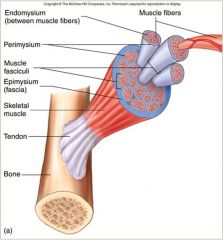
Fasciculi
|

A muscle is composed of numerous visible bundles called muscle fasiculi, which are surrounded by loose connective tissue called the perimysium.
|
|

Muscle Fiber
|

A fasciculus is composed of several muscle cells, which are called muscle fibers. Each muscle fiber is surrounded by loose connective tissue called endomysium.
|
|
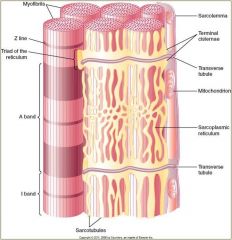
Transverse Tubules
|

Along the suface of the sarcolemma are many tublike invaginations, called transverse tubules, or T tubules, which occur at regular intervals along the muscle fiber and extend inward into it. The T Tubules are associated with a highly organized smooth endoplasmic reticulum called the sarcoplasmic reticulum.
|
|
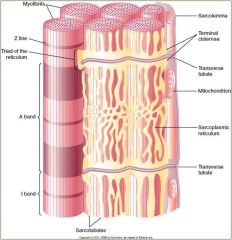
Sarcolemma
|

The cell membrane of the muscle fiber is called the sarcolemma. The multiple nuclei of the muscle fiber are located just deep tot he sarcolemma.
|
|
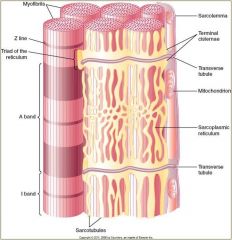
Sarcoplasmic Reticulum
|

The T Tubules are associated with a highly organized smooth endoplasmic reticulum. T tubules connect the sarcolemma to the sarcoplasmic reticulum. The sarcoplasmic reticulum has a relatively high concentration of Ca, which play a major role in muscle contraction.
|
|

Sarcomere
|

The actin and myosin myofilaments are arranged into highly ordered, repeating units along the myofibril called sarcomeres.
|
|

Actin
|

Actin myofilaments, or thin filaments, are made up of three components; actin, troponin, and tropomyosin. The actin myofilaments, which resemble two minute strands of pearls twisted together, have attachment sites for the myosin myofilaments.
|
|

Myosin
|

Myosin myofilaments, or thick myofilaments, resemble bundles of minute golf clubs. The parts of the myosin molecule that resemble golf club heads are referred to as myosin heads. The myosin heads have three important properties; The heads can bind to attachment sites on the actin myofilaments; they can bend and traighten during contraction; and they can break down ATP, releasing energy.
|
|

Troponin
|

Troponin molecules are attached at specific intervals along the actin myofilaments. These molecules have binding sites for Ca.
|
|

Tropomyosin
|

Tropomyosin filaments are located along the groove between the twisted strands of actin myofilament subunits. The tropomyosin filaments block the myosin myofilament binding sites on the actin myofilaments in an unstimulated muscle.
|
|
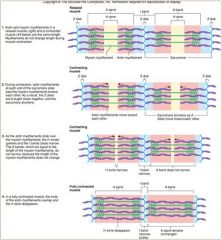
Sliding Filament Model
|

Contraction of skeletal muscle tissue occurs as actin and myosin myofilaments slide past one another, causing the sarcomeres to shorten. Many sarcomeres joined end to end form myofibrils. Shortening of the sarcomeres causes myfibrils to shorten, thereby causing the entire muscle to shorten. This is referred to as the sliding filament model.
During contraction, neither the actin nor the myosin fibers shorten. The H zones and I bands shorten during contraction, but the A bands do not change in length. During muscle relaxation, sarcomeres lengthen. This lengthening requires an opposing force, such as that produced by other muscles or by gravity. |
|
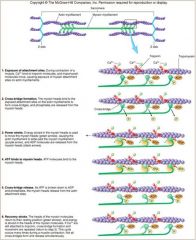
Cross-Bridge Cycling
|

During contraction of a muscle, Ca bind to troponin molecules, causing tropomyosin molecules to move, which exposes myosin attachment sites on actin myofilaments.
The myosin heads bind tot he exposed attachment sites on the actin myofilaments to form cross-bridges, and phosphates are released from the myosin heads. Energy stored in the myosin heads is used to move the myosin heads, causing the actin myofilament to slide past the myosin myofilament, and ADP molecules are released from the myosin heads. ATP molecules bind to the myosin heads. As ATP is broken down to ADP and phosphates, the myosin heads release from the actin attachment sites. The heads of the myosin molecules return to their resting position, and enrgy is stored in the ehads of the myosin molecules. If Ca are still attached to troponin, cross-bridge formation and movement are repeated. This cycle occurs many times during a muscle contraction. Not all cross-bridges form and release simultaneously. |
|
|
Resting Membrane Potential
|
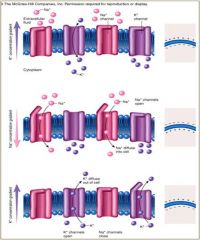
The inside of most cell membranes is negatively charged compared to the outside of the cell membrane; in other words, the cell membrane is polarized. The charge difference, called the resting membrane potential, occurs because there is an uneven distribution of ions across the cell membrane. The resting membrane potential develops for three reasons; the concentration of K inside the cell membrane is higher than outside the cell membrane; the concentration of Na outside the cell membrane is higher than inside the cell membrane; and the cell membrane is more permeable to K than it is to Na.
|
|
|
Action Potential
|
The rapid depolarization and repolarization of the cell membrane is called an action potential. In a muscle fiber, an action potential results in muscle contraction.
|
|
|
Depolarization & Repolarization
|
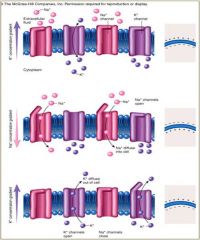
Resting membrane potential = Na channels and some, but not all, K channels are closed. A few K diffuse down their concentration gradient through the open K channels, making the inside of the cell membrane negatively charged compared to the outside.
Depolarization = Na channels are open. A few Na diffuse down their concentration gradient through the open Na channels, making the inside of the cell membrane positively charged compared to the outside. Repolarization = Na channels are closed, and Na movement into the cells stops. More K channels open. K movement out of the cell increases, making the inside of the cell membrane negatively charged compared to the outside once again. |
|
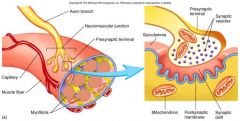
Motor Neurons
|

Motor neurons are specialized nerve cells that stimulate muscles to contract. Motor neurons generate action potentials that travel to skeletal muscle fibers. Axons of these neurons enter muscles and send out branches to several muscle fibers.
|
|
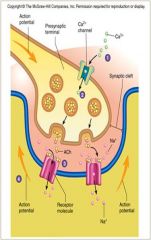
Neuromuscular Junction
|

Axons of motor neurons enter muscles and send out branches to several muscle fibers. Each branch forms a junction with a muscle fiber, called a neuromuscular junction. A more general term, synapse, refers to the cell-to-cell junction between a nerve cell and either another nerve cell or an effector cell, such as a muscle or gland cell. Neuromuscular junctions are located near the center of a muscle fiber.
|
|
|
Motor Unit
|
A single motor neuron and all the skeletal muscle fibers it innervates constitute a motor unit. The fewer fiber there are in the motor units of a muscle, the greater control you have over that muscle. Many muscle units constitute a single muscle.
|
|
|
Myasthenia Gravis
|
Myasthenia gravis is an autoimmune disorder in which antibodies are formed against acteylcholine receptors. As a result, acetylcholine receptors in the postsynaptic membranes of skeletal muscles are destroyed. With fewere receptors, acetylcholine is less likely to stimulate muscle contraction, resulting in muscle weakness and fatigue.
autoimmune condition, your antibodies bind to receptors, causing muscle disfunction Very critical with diaphragm |
|
|
Rigor Mortis
|
After a person dies, ATP is no longer available, and the cross bridges that have formed are not released, causing the muscles to become rigid.
stiffness of death Dead people don’t make atp, so they are locked |
|
|
Creatine Phosphate
|
Creatine Phosphate provides a means of storing energy that can be used rapidly to help maintain an adequate amount of ATP in a contracting muscle fiber. During periods of inactivity, as excess ATP is produced in the muscle fiber, the energy contained in the ATP is used to synthesize creatine phosphate. During periods of activity, the small reserves of ATP in the cell are used first. Then the energy stored in creatine phsophate is accessed quickly to produce ATP, which is used in muscle contraction and to restore ATP reserves.
|
|
|
Myoglobin
|
Myoglobin can continue to release oxygen in a muscle even when a sustained contraction has interrupted the continuous flow of blood.
Myo - muscle, globin - oxygen |
|
|
Hypertrophy
|
Muscle fibers are enlargening
|
|
|
Duchenne's Muscular Dystrophy
|
Duchenne’s muscular dystrophy is the most common childhood form of MD
Etiology Dystrophin mutation X-linked (Anchors sarcomeres to cell membrane Protects fibers against mechanical stress) If not functioning properly the muscle fibers actually die and are replaced with fat Clinical course Diagnosed by age 3 Progressive muscle weakness and atrophy Life expectancy: late teens to mid 20s Incidence 1 in 3,000 boys *(because of only x chromosone, since it acts on x) Rarely girls |
|
|
Dystrophin
|
a vital part of a protein complex that connects the cytoskeleton of a muscle fiber to the surrounding extracellular matrix through the cell membrane
mutation in genes causes Duchenne's Muscular Dystrophy |
|
|
Smooth Muscle Fibers
|
Involuntary Control
Locations Walls of hollow organs Vasculature Bronchioles Iris and ciliary body in eyes Functions Under involuntary control Autonomic nervous system Produce motility Propel food in the GI tract Maintain tension Vascular tone |
|
|
Unitary Smooth Muscle
|
Unitary smooth muscle
Gap junctions Coordinated contraction Gastrointestinal tract, bladder, and ureters Spontaneous activity |
|
|
Multiunit Smooth Muscle
|
Multiunit smooth muscle
Each fiber behaves as a separate motor unit Fine motor control Iris, ciliary muscles of lens, and vas deferens |
|
|
Motor Unit
|

A single motor neuron and all the skeletal muscle fibers it innervates constitute a motor unit.
|
|
|
Muscle Twitch
|
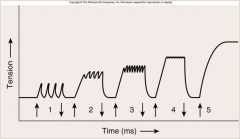
A muscle twitch is the contraction of a muscle fiber in response to a stimulus. Because most muscle fibers are grouped into motor units, a muscle twitch usually involves all the muscle fibers in a motor unit.
A muscle twitch has three phases: Lag phase - the time between the application of a stimulus and the beginning of contraction Contraction phase - the time during which the muscle contracts Relaxation phase - the time during which the muscle relaxes |
|
|
Tetanus
|
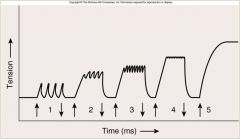
Tetanus is a sustained contraction that occurs when the frequency of stimulation is so rapid that no relaxation occurs. The increased force of contraction produced in summation and tetanus occurs because Ca build up in myofibrils, which promotes cross-bridge formation and cycling. The buildup of Ca occurs because the rapid production of action potentials in muscle fibers causes Ca to be released from the sarcoplasmic reticulum faster than they are actively transported back into the sarcoplasmic reticulum.
|
|
|
Recruitment
|
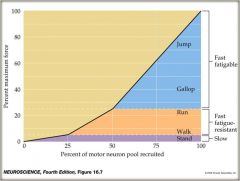
In recruitment, the number of muscle fibers contracting is increased by increasing the number of motor units stimulated, and the muscle contracts with more force. When only a few motor units are stimulated, a small force of contraction is produced because only a small number of muscle fibers are contracting. As the number of motor units stimulated increases, more muscle fibers are stimulated to contract, and the force of contraction increases. Maximum force of contraction is produced in a given muscle when all the motor units of that muscle are stimulated (recruitment).
If all the motor units in a muscle could be stimulated simultaneously, the resulting motion would be quick and jerky. However, because the motor units are recruited gradually, some are stimulated and held in tetanus while additional motor units are recruited; thus, contractions are slow, smooth, and sustained. In the same way, smooth relaxation of muscle occurs because some motor units are held in tetanus while other motor units relax. |
|
|
Summation
|

In summation, the force of contraction of individual muscle fibers is increased by rapidly stimulating them. When stimulus frequency, which is the number of times a motor neuron is stimulated per second, is low, there is time for complete relaxation of muscle fibers between muscle twitches. As stimulus frequency increases there is not enough time between contraction for muscle fibers to relax completely. Thus one contraction summates, or is added onto, a previous contraction. As a result, the overall force of contraction increases.
|
|
|
Major functions of the muscular system?
|
Movement
Posture Respiration Heat production Organ/vessel constriction Heart contraction |
|
|
Describe how muscle fibers are organized within muscle tissue
|
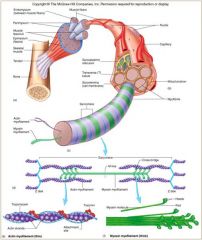
|
|
|
Muscle Fiber cells and organelles....
|
nuclei - near surface, create proteins
mitochondria - many T Tubules - reach across and connect sarcoplasmic reticulum to cell membrane (here is where action potential) Sarcoplasmic reticulum - houses lots of calcium (which open calcium channels and allow for cross bridge cycling to take place) |
|
|
Myofilament Structure - describe how it contracts
|
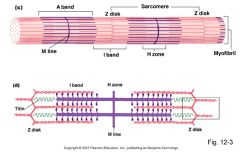
|
|
|
Describe how flow of ions lead to the resting membrane potential and the generation of action potentials
|
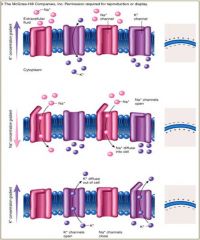
|
|
|
Briefly describe the steps involved in synaptic transmission of an action potential across the neuromuscular junction
|
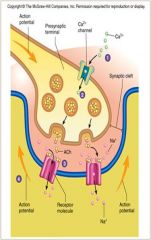
Each presynaptic terminal (axon) contains many small vesicles, called synaptic vesicles. These vesicles contain acetylcholine, or ACh, which functions as a neurotransmitter, a molecule released by a presynaptic nerve cell that stimulates or inhibits a prostynaptic cell. When an action potential reaches the presynaptic terminal, it causes Ca channels to open. Ca enter the presynaptic terminal ancd cause several synaptic vesicles to release acetylcholine into the synaptic cleft by exocytosis. The acetylcholine diffuses across the synaptic cleft and binds to acetylcholine receptor sites on the Na channels in the muscle fiber cell membrane. The combination of acetylcholine with its receptor opens Na channels and therefore makes the cell membrane more permeable to Na. The resulting movement of Na into the muscle fiber initiates an action potential, which travels along the length of the muscle fiber and causes it to contract. The acetylcholine released into the synaptic cleft between the neuron and muscle fiber is rapidly broken down by an enzyme, acetylcholinesterase. This enzymatic breakdown ensures that one action potential in the neuron yields only one action potential in the skeletal muscle fibers of that motor unit and only one contraction of each muscle fiber.
|
|
|
What occurs when an action potential migrates down the T tubule of a muscle fiber? Why is this important?
|
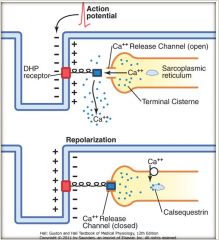
|
|
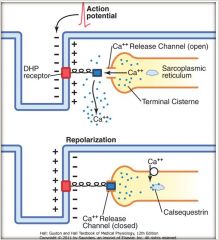
How does an increase in intracellular Ca initiate cross-bridge cycling? What role does ATP play in cross-bridge cycling?
|

|
|
|
How does muscle fiber relaxation occur?
|

Muscle fiber relaxation occurs with a lack of motor neuron stimulation.
Ca2+ is pumped back into the sarcoplasmic reticulum and intracellular levels decrease. |
|
|
Why do some muscles contain smaller motor units while other contain larger motor units? Provide an example for both circumstances.
|
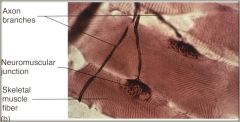
Smaller Motor Units = fine motor control, such as the eyes
Larger Motor Units = gross motor control, such as the legs |
|
|
Why does tetanus produce not only prolonged contraction but a greater force of contraction?
|
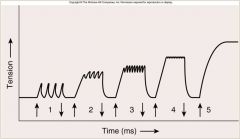
Continuous Action Potential
It happens so fast that the Calcium channels in the Sarcoplasmic Reticulum remain open so that Ca can continue to flow. This causes more cross bridge cycling = tension |
|
|
What mechanism ensures that muscle contractions are slow and sustained rather than rapid and jerky? Explain.
|
Recruitment controls the amount of stimulus, so that motor units are gradually held in tetanus while other are recruited (some are in tetanus while other motor units are relaxing)
|
|
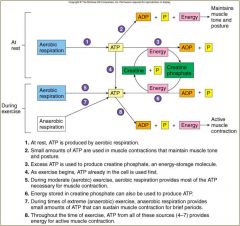
Contrast how a muscle would obtain energy while at rest versus while intensely exercising. Why do these differences occur?
|

Resting or moderate=
Aerobic respiration Creatine phosphate storage at rest Fatty acids most important source Most Efficient Breaking down Fuel in the presence of Oxygen to make ATP Intense exercise= Anaerobic respiration ATP reserves quickly consumed (not enough) Glycogenolysis (use up all your glucose stores) Lactic acid buildup Limited by glucose Breaking down energy WITHOUT Oxygen (less efficient) |
|
|
Contrast Slow and Fast Twitch Fibers
|
Slow Twitch = Endurance
Many Mitochondria Aerobic Metabolism High Fatigue Resistance High Myoglobin Content Low Glycogen Content Fast Twitch = Strength Few Mitochondria Anaerobic Metabolism Low Fatigue Resistance Low Myoglobin Content High Glycogen Content |
|
|
Where is smooth muscle found in the body? What are its functions?
|
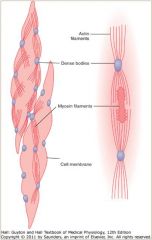
Locations
Walls of hollow organs Vasculature Bronchioles Iris and ciliary body in eyes Around Arteries and Blood vessels Functions Under involuntary control Autonomic nervous system Produce motility Propel food in the GI tract Maintain tension Vascular tone Helps maintain blood pressure (like sitting and standing) |
|
|
Contrast the functions of unitary and multiunit smooth muscle.
|

Unitary smooth muscle
Gap junctions Coordinated contraction Gastrointestinal tract, bladder, and ureters Spontaneous activity Multiunit smooth muscle Each fiber behaves as a separate motor unit Fine motor control Iris, ciliary muscles of lens, and vas deferens |
|
|
Cramps
|
Pianful, spastic contractions of a muscle; usually due to a buildup of lactic acid
|
|
|
Fibromyalgia
|
Non-life-threatening, chronic, widespread pain in muscles with no known cure; also known as chronic muscle pain syndrome
|
|
|
Hypertrophy
|
Enlargement of a muscle due to an increased number of myfibrils, as occurs with increased muscle use
|
|
|
Atrophy
|
Decrease in muscle size due to a decreased number of myofilaments; can occur due to disuse of a muscle, as in paralysis
|
|
|
Tendinitis
|
Inflammation of a tendon or its attachment point due to overuse of the muscle
|
|
|
Inferior (Caudal)
|
Below
The neck is inferior to the head |
|
|
Anterior (Ventral)
|
Closer to front of body
The lips are anterior to the teeth |
|
|
Posterior (Dorsal)
|
Closer to back of body
The teeth are posterior to the lips |
|
|
Medial
|
Closer to midline of body
The nose is medial to the eyes |
|
|
Lateral
|
Farther from midline of body
The eyes are lateral to the nose |
|
|
Intermediate
|
Between two structures
The elbow is intermediate between the shoulder and the wrist |
|
|
Ipsilateral
|
On same side of body
The right arm and right leg are ipsilateral |
|
|
Contralateral (Peripheral)
|
On opposite sides of body
The right arm and left arm are contralateral |
|
|
Proximal
|
Nearer to point of attachment of limb to trunk
The elbow is proximal to the wrist |
|
|
Distal
|
Farther from point of attachment of limb to trunk
The wrist is distal to the elbow |
|
|
Superficial
|
Closer to surface of body
The skin is superficial to the muscles |
|
|
Deep
|
Farther from surface of body
The muscles are deep to the skin |
|
|
Cervical
|
neck
|
|
|
Thoracic
|
chest
|
|
|
Pectoral
|
breast
|
|
|
Sternal
|
breast bone
|
|
|
Abdominal
|
abdomen
|
|
|
Umbilical
|
navel
|
|
|
Coxal
|
hip
|
|
|
Pelvic
|
pelvis
|
|
|
Pubic
|
genital area
|
|
|
Dorsal
|
back
|
|
|
Scapular
|
shoulder blade region
|
|
|
Vertebral
|
spinal column
|
|
|
Lumbar
|
the area of the back between the lowest rib and buttocks
|
|
|
Acromial
|
highest point of the shoulder
|
|
|
Axillary
|
armpit
|
|
|
Brachial
|
arm
|
|
|
Cubital
|
elbow
|
|
|
Antecubital
|
Anterior surface of the elbow
|
|
|
Olecranal
|
posterior surface of the elbow
|
|
|
Antebracial
|
forearm
|
|
|
Carpal
|
wrist
|
|
|
Manual
|
hand
|
|
|
Palmer
|
palm of the hand
|
|
|
Digital
|
digits
|
|
|
Inguinal
|
grown where the thigh attaches to the pelvis
|
|
|
Gluteal
|
buttocks
|
|
|
Femoral
|
thigh
|
|
|
Patellar
|
anterior surface of the knee
|
|
|
Popliteal
|
posterior surface of the knee
|
|
|
Crural
|
anterior surface of the leg
|
|
|
Sural
|
posterior surface of the leg
|
|
|
Fibular
|
lateral side of the leg
|
|
|
Tarsal
|
ankle
|
|
|
Pedal
|
foot
|
|
|
Calcaneal
|
heel
|
|
|
Plantar
|
sole of foot
|
|
|
Parietal ....
|
Outer wall or lining
|
|
|
Visceral ....
|
Inner wall or lining
|
|
|
Pericardial Cavity
|
the cavity surrounding the heart
|
|
|
Pleural cavity
|
the cavity surrounding the lungs
|
|
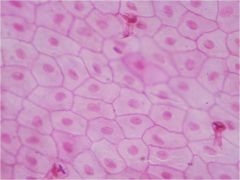
|

Simple Squamous Epithelium
|
|
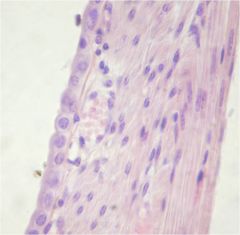
|

Simple Cuboidal Epithelium
|
|
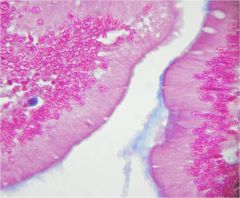
|

Simple Columnar Epithelium
|
|

|
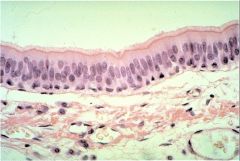
Pseudostratified Columnar Ciliated Epithelium
|
|
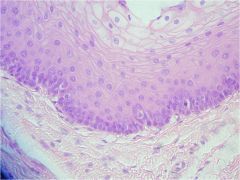
|

Stratified Squamous Epithelium
|
|
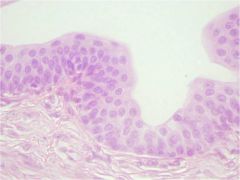
|

Transitional Epithelium
|
|
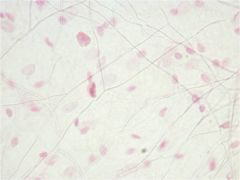
|

Areolar Tissue
|
|

|
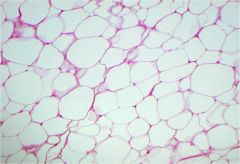
Adipose Connective Tissue
|
|
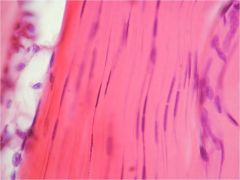
|

Dense Regular Connective
|
|
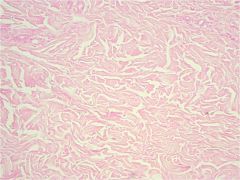
|

Dense Irregular Connective
|
|
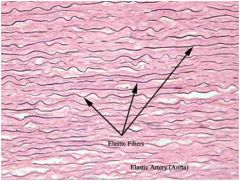
|

Elastic Connective
|
|
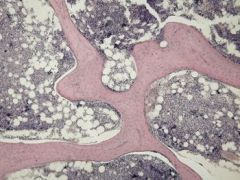
|

Spongy or Cancellous Bone Tissue
|
|
|
Axial
|
Pertaining to the central part of the body, the head and trunk
|
|
|
Appendicular
|
Pertaining to the extremities or limbs
|
|
|
Cephalic
|
head
|
|
|
Facial
|
face
|
|
|
Frontal
|
forehead
|
|
|
Orbital
|
eye
|
|
|
Otic
|
ear
|
|
|
Buccal
|
cheek
|
|
|
Oral
|
mouth
|
|
|
Cranial
|
pertaining to the portion of the skull surrounding the brain
|
|
|
Occipital
|
the back of the head
|
|
|
Tuberosity
|
rough projection or elevation
Ex: tibia |
|
|
Crest
|
Ridgelike
Ex: hip bone |
|
|
Epicondyle
|
superior to condyle
Ex: femur |
|
|
Line
|
slightly raised ridge
Ex: femur |
|
|
Process
|
prominent
Ex: vertebra |
|
|
Protuberance
|
outgrowth
Ex: skull |
|
|
Ramus
|
extension
Ex: hip bone |
|
|
Spine
|
sharp slender, thornlike
Ex: scapula |
|
|
Trochanter
|
large blunt shape
Ex: femur |
|
|
Tubercle
|
knoblike
Ex: humerus |
|
|
Condyle
|
rounded process
Ex: skull |
|
|
Facet
|
nearly flat
Ex: vertebra |
|
|
Head
|
Expanded end
Ex: femur |
|
|
Lacrimal
|
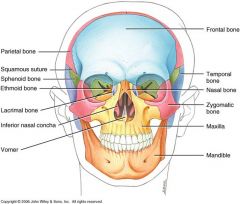
2
Lacrimal fossa (tear ducts) |
|
|
Vomer
|

1
divides nostrals at nose end |
|
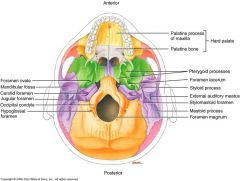
Maxilla
|

2
Alveoli Palatine Process (cleft palate) |
|
|
Inferior Nasal Concha
|
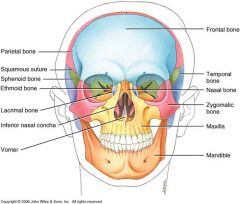
2
Help with cleaning in the nose |
|
|
Palatine
|
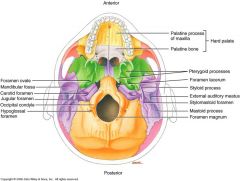
2
|
|
|
Zygomatic
|
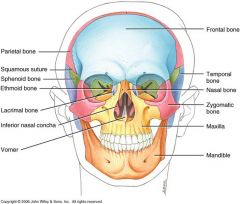
2
|
|
|
Auditory Ossicles
|
SMALLEST bones in the body
contains the Malleus Incus Stapes |
|
|
Sinuses purpose?
|
lessen the tension on our heads and necks.
4 found in frontal, maxillary, ethmoid and sphenoid |
|
|
Vertebral Column
|
26 bones
Vertebra Intervertebral Discs Cervical Thoracic Lumbar Sacrum Coccyx |
|
|
Vertebra & Intervertebral Discs
|
Body
Vertebral Foramen Intervertebral Foramen Superior & Inferior Articular Facets Transverse Process Spinous Process (C7) |
|
|
Cervical Vertebra
|
7
Atlas (C1) - No body Axis (C2) - Dens C1-C6: "Triangular" Foramen (Bifurcated) Spinous Process Transverse Foramen Transverse Process Vertebral Foramen Lamina Pedicle Superior Articular Process Inferior Vertebral Notch Body Spinous Process (C7) |
|
|
Atlas (C1)
|
Transverse Process
Transverse Foramen Vertebral Foramen |
|
|
Axis (C2)
|
Body
Dens Facet that articulates with occipital condyle Spinous Process Superior articular fact transverse process transverse foramen vertebral foramen |
|
|
Thoracic Vertebra
|
T1-T12
(Heart shaped) body inferior vertebral notch lamina pedicle Spinous process Superior articulared process transverse (oval) foramen transverse process vertebral foramen demifacets on body articulate with head of rib facets on transverse process articulate with tubercle of rib |
|
|
Lumbar Vertebra
|
L1-L5
Body Inferior vertebral notch lamina pedicle (hatchet shaped) spinous process superior articular process transverse foramen transverse process vertebral foramen It is the largest |
|
|
Sacrum
|
5 fused
Sacral crest Ala Sacral Canal Sacral Promontory Auricular Surface Anterior sacral foramen Posterior sacral foramen Sacral Hiatus Superior Articular Process |
|
|
Coccyx
|
3-5 fused
|
|
|
Thoracic Cage
|
Sternum
Ribs |
|
|
Sternum
|
3 bones
Manubrium - Jugular Notch - Sternal Angle (opposite 2nd rib) Body of Sternum Xiphoid (this is cartilage, ossifys completely by age 40) |
|
|
Ribs
|
12 pairs
True Ribs (7) - Costal Hyaline Cartilage connected False Ribs (5) - last 2 pairs are called floating Markings head - to demifacets on body neck Tubercle - to facet on transverse process Body |
|
|
Appendicular
|
126 bones in all
Pectoral Girdle Forelimb Wrist Palm Digits Pelvic Girdle Ankle Sole Toes |
|
|
Pectoral Girdle
|
Clavicle
Scapula |
|
|
Clavicle
|
2
Sternal end Acromial End Breaks most often |
|
|
Scapula
|
2
Spine Acromion (highest point of your shoulder) Caracoid Process (named after crow) Glenoid Cavity Inferior Angle infraspinous fossa lateral border supraspinous fossa Breaks least often |
|
|
Forelimb
|
Humerus
Radius Ulna |
|
|
Humerus
|
2
Head Anatomical Neck Surgical Neck Greater & lesser Tubercle Intertubercular sulcus deltoid tuberosity medial & lateral epicondyle coronoid fossa capitulum (little head) olecranon fossa trochlea |
|
|
Radius
|
2
Head Styloid Process of Radius Radial Tuberosity |
|
|
Ulna
|
2
Olecranon Trochlear notch coronoid process Radial notch of ulna Ulnear notch of radius Head of ulna |
|
|
Ribs
|
12 pairs
True Ribs (7) - Costal Hyaline Cartilage connected False Ribs (5) - last 2 pairs are called floating Markings head - to demifacets on body neck Tubercle - to facet on transverse process Body |
|
|
Appendicular
|
126 bones in all
Pectoral Girdle Forelimb Wrist Palm Digits Pelvic Girdle Ankle Sole Toes |
|
|
Pectoral Girdle
|
Clavicle
Scapula |
|
|
Clavicle
|
2
Sternal end Acromial End Breaks most often |
|
|
Scapula
|
2
Spine Acromion (highest point of your shoulder) Caracoid Process (named after crow) Glenoid Cavity Inferior Angle infraspinous fossa lateral border supraspinous fossa Breaks least often |
|
|
Forelimb
|
Humerus
Radius Ulna |
|
|
Humerus
|
2
Head Anatomical Neck Surgical Neck Greater & lesser Tubercle Intertubercular sulcus deltoid tuberosity medial & lateral epicondyle coronoid fossa capitulum (little head) olecranon fossa trochlea |
|
|
Radius
|
2
Head Styloid Process of Radius Radial Tuberosity |
|
|
Ulna
|
2
Olecranon Trochlear notch coronoid process Radial notch of ulna Ulnear notch of radius Head of ulna |
|
|
Ribs
|
12 pairs
True Ribs (7) - Costal Hyaline Cartilage connected False Ribs (5) - last 2 pairs are called floating Markings head - to demifacets on body neck Tubercle - to facet on transverse process Body |
|
|
Appendicular
|
126 bones in all
Pectoral Girdle Forelimb Wrist Palm Digits Pelvic Girdle Ankle Sole Toes |
|
|
Pectoral Girdle
|
Clavicle
Scapula |
|
|
Clavicle
|
2
Sternal end Acromial End Breaks most often |
|
|
Scapula
|
2
Spine Acromion (highest point of your shoulder) Caracoid Process (named after crow) Glenoid Cavity Inferior Angle infraspinous fossa lateral border supraspinous fossa Breaks least often |
|
|
Carpals (16)
|
So long top part her comes the thumb
Scaphoid (Largest Carpal) Lunate (Crescent Moon shaped) Triquetrum Pisiform (small pea) Hamate (hook) Capitate (head) Trapezoid Trapezium |
|
|
Metacarpals (10) & Phalanges (28)
|
Metacarpals
Middle Distal Proximal |
|
|
Coxal Bone
|
2
Pelvic Brim True Pelvis False Pelvis Obturator Foramen (Largest Foramen in the body) Acetabulum |
|
|
Ilium
|
2
Iliac Crest (this is where you rest your hands on your hips) Greater Sciatic Notch Spine |
|
|
Ischium
|
2
Ischial Tuberosity (that's what you sit on) Spine |
|
|
Pubis
|
2
Pubic Symphasis Spine |
|
|
Femur
|
2
head neck Fovea Capitis Greater and lesser Trochanter (only found in femurs) Gluteal Tuberosity Linea Aspera (feels like a ridge on posterior side) Lateral and Medial epicondyle lateral and medial condyle shaft (Old people break their Femur not their hips) |
|
|
Patella
|
2
largest sesamoid bone |
|
|
Tibia
|
2
Medial and lateral condyles tibial tuberosity anterior crest medial malleolus anterior border makes up the knee |
|
|
Fibula
|
2
head (triangular) Lateral Malleolus distal tibiofibular joint Makes up the larger part of the ankle |
|
|
Tarsals (14)
|
Calcaneous (heel bone)
Talus (2nd largest bone) Cuboid (cube shaped) Navicular (looks like the hull of a ship) Lateral, Intermediate & medial Cuneiforms (these make up the ankle bones |
|
|
Sole has Metatarsals (10) & Phalanges (28)
|
metatarsals
proximal middle distal |
|
|
Hyoid Bone
|
The only bone that does not articulate with any other bone
Attachment for tongue and holds Trachea. When strangled this bone is broken. |
|
|
Age a skull
|
Sutures to look at:
Lambdoidal Suture Point between Lambdoidal and Sagittal Sagittal Suture mid and top point between sagittal and coronal Coronal Suture Mid and end 0 = open 1 = minimal closure 2 = significant closure 3 = completely obliterated |
|
|
Sex the Skull
|
handout....
|
|
|
2D:4D
|
Women tend to be 1:1
Men tend to be <1:1 because testosterone affects the their 4th digit Athletes tend to have more compressed digits cuz of wear |

